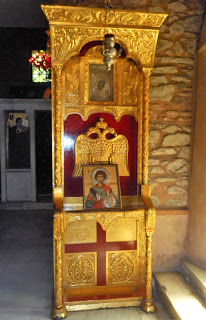Thessaloniki [θesaloˈnici] (listen)), also known as Thessalonica (English: /ˌθɛsələˈnaɪkə, ˌθɛsəˈlɒnɪkə/), Saloniki or Thessaloniki Salonica (/səˈlɒnɪkə, ˌsæləˈniːkə/), Solun – in Bulgarian, is the second-largest city in Greece, with over 1 million inhabitants in its metropolitan area, and the capital of Greek Macedonia, the administrative region of Central Macedonia and the Decentralized Administration of Macedonia and Thrace. It is also known in Greek as η Συμπρωτεύουσα (i Symprōtévousa), literally "the co-capital", a reference to its historical status as the Συμβασιλεύουσα (Symvasilévousa) or "co-reigning" city of the Eastern Roman (Byzantine) Empire, alongside Constantinople.
Thessaloniki is located on the Thermaic Gulf, at the northwest corner of the Aegean Sea. It is bounded on the west by the delta of the Axios/Vardar. The municipality of Thessaloniki, the historical center, had a population of 325,182 in 2011, while the Thessaloniki Urban Area had a population of 824,676 and the Thessaloniki Metropolitan Area had 1,030,338 inhabitants in 2011. It is Greece's second major economic, industrial, commercial and political center; it is a major transportation hub for Greece and southeastern Europe, notably through the Port of Thessaloniki. The city is renowned for its festivals, events and vibrant cultural life in general, and is considered to be Greece's cultural capital. Events such as the Thessaloniki International Fair and the Thessaloniki International Film Festival are held annually, while the city also hosts the largest bi-annual meeting of the Greek diaspora. Thessaloniki was the 2014 European Youth Capital. The city of Thessaloniki was founded in 315 BC by Cassander of Macedon. An important metropolis by the Roman period, Thessaloniki was the second largest and wealthiest city of the Byzantine Empire. It was conquered by the Ottomans in 1430, and remained an important seaport and multi-ethnic metropolis during the nearly five centuries of Turkish rule. It passed from the Ottoman Empire to Greece on 8 November 1912. It is home to numerous notable Byzantine monuments, including the Paleo Christian and Byzantine monuments of Thessaloniki, a UNESCO World Heritage Site, as well as several Roman, Ottoman and Sephardic Jewish structures. The city's main university, Aristotle University, is the largest in Greece and the Balkans.
Thessaloniki is a popular tourist destination in Greece. In 2013, National Geographic Magazine included Thessaloniki in its top tourist destinations worldwide, while in 2014 Financial Times FDI magazine (Foreign Direct Investments) declared Thessaloniki as the best mid-sized European city of the future for human capital and lifestyle. Among street photographers, the center of Thessaloniki is also considered the most popular destination for street photography in Greece. The main places to see in Solun – Thessaloniki are:
1.Aristotle Square, 2.Church of Saint Demetrius, 3.Thessaloniki Concert Hall, 4.Thessaloniki's waterfront and 5.White Tower of Thessaloniki.
We went around all this places, entered in the Church of St. Dimitar (Demetrius), took a photos with Aristotle and Alexander The Great, in front of White towel look at the city from old Castle on the Hill and took some small Cruise Ship to look at the this beautiful city from the Bay. We didn’t see any monuments of the Brothers “St.St.Ciryl & Metodii”, 10 century’s Bulgarian Scientist, born ad worked in Solun, creators of Slavic Alphabet, used now from all Bulgarians, Macedonians (from Yugoslavia) Ukrainians and Russians.We received Christianity from Byzantium in 845 y. and later Russians received it from us with all Church books (Evangelias -Bibles) written in Slavic Alphabet. Probably because they were Bulgarians, not Greeks. Like Aristotle and Alexander the Great….
Ww with Ventzi, Kristi and Kalinka visited Solun by Bus from “Alexander Nevski” Square with some touristic Company. We met there at 6:00 am, climbed the bus, crossed all Bulgarian Macedonia through Kulata (on the border) and after 3 hours were in Solun, stopped only one time for coffee. From 9 am till 5 pm we were everywhere around Solun. Part of my photos are in this 1st Album, another smaller part – in the next second album for this beautiful city, the prettiest in all Balkan peninsula, may by after Constantinople….
We went around all this places, entered in the Church of St. Dimitar (Demetrius), took a photos with Aristotle and Alexander The Great, in front of White towel look at the city from old Castle on the Hill and took some small Cruise Ship to look at the this beautiful city from the Bay. We didn’t see any monuments of the Brothers “St.St.Ciryl & Metodii”, 10 century’s Bulgarian Scientist, born ad worked in Solun, creators of Slavic Alphabet, used now from all Bulgarians, Macedonians (from Yugoslavia) Ukrainians and Russians.We received Christianity from Byzantium in 845 y. and later Russians received it from us with all Church books (Evangelias -Bibles) written in Slavic Alphabet. Probably because they were Bulgarians, not Greeks. Like Aristotle and Alexander the Great….
Ww with Ventzi, Kristi and Kalinka visited Solun by Bus from “Alexander Nevski” Square with some touristic Company. We met there at 6:00 am, climbed the bus, crossed all Bulgarian Macedonia through Kulata (on the border) and after 3 hours were in Solun, stopped only one time for coffee. From 9 am till 5 pm we were everywhere around Solun. Part of my photos are in this 1st Album, another smaller part – in the next second album for this beautiful city, the prettiest in all Balkan peninsula, may by after Constantinople….























































